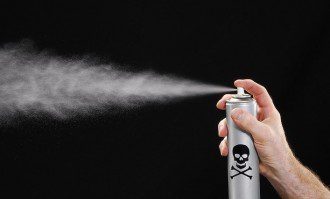By Elisha McFarland N.D.
Guest writer for Wake Up World
The average American spends 90 percent of their time indoors. While people are aware of the health risk caused by outdoor air pollution, few may consider that indoor air quality can also have a negative impact on their health. According to the EPA levels of indoor air pollutants can be 2 to 5 times higher than outdoor pollution levels. In fact indoor air pollutants are ranked among the top five environmental risks to public health.
Since we spend so much time indoors it is important to create a healthy, toxin-free indoor environment that is safe for everyone. Here is a list of toxic products you may like to consider banning from your home, plus some healthier alternatives to help you do it.
Toxic Products to Ban From Your Home
1. Non Stick Cookware
It’s been 40 years since nonstick pans were introduced. Although the concept is appealing to most cooks, the hazards just aren’t worth it. Nonstick coating is made of polytetrafluoroethylene which release toxic gasses that are linked to cancer, organ failure, reproductive damage and other health risks.
Healthier Options: Consider using stainless steel pans, cast iron or anodized aluminum, which is less reactive than regular aluminum.
2. Conventional Cleaning Supplies
All-purpose cleaners frequently contain toxic chemicals such as ammonia which is a very strong irritant that can cause liver and kidney damage, or bleach which can burn your skin and eyes, and irritate your lungs. Oven cleaners and drain cleaners can cause chemical burns and emit toxic fumes that harm your lungs.
Healthier Options: Consider nontoxic cleaning products such as Seventh Generation, or make your own from ingredients around the house, such as baking soda and vinegar. Click here to learn more about effective home-made cleaners.
3. Air Fresheners
As time passes more negative effects are associated with these incredibly toxic products. Whether they are solids, aerosols, automatic sprayers, diffusers, or plug ins, it doesn’t matter. Air fresheners aggravate and trigger respiratory problems, reproductive problems, birth defects, and are now being linked to breast cancer, heart disease and diabetes.
Healthier Options: Consider open windows, air cleaners, search for the origin of the offending odor and remove it, or my favorite bake some cookies! Click here to read more about air fresheners.
4. CFL Light Bulbs
People may appreciate the efficiency of these bulbs, as they use less electricity. But unless you plan on operating a hazardous waste dump in your home, avoid these as they contain mercury. If you do use these bulbs, they should be taken to a “special facility” or hazardous waste collection site.
Healthier Options: Consider sticking with the “old fashion” light bulb or LEDs till something better comes along.
5. Chemical Insecticides and Herbicides
Pests and weeds may be problematic, but not nearly as much as the problems created by their use. Round Up is known to create a host of physical ills including kidney and reproductive damage in lab mice. Bug sprays commonly contain cypermethrin, a known eye, skin and respiratory irritant; it is also known to have negative effects on the central nervous system.
Healthier Options: Consider Diatomaceous Earth, or a peppermint castile soap for insects and straight vinegar as a weed killer.
6. Chemical Fertilizers
When it rains or you water you lawn, chemical runoff enters the storm drains. This chemical soup eventually ends up in streams, rivers and the ocean, killing wildlife and destroying water quality.
Healthier Options: Consider an organic fertilizer or using homemade compost, or even more eco-friendly consider a xeriscape yard or replacing your grass with a vegetable garden.
7. Flame Retardants
This is tough one, since flame retardants are everywhere. They are used in cushions, mattresses, foam pillows, hair dryers, tvs, computers, carpets, appliances, fabrics, even your telephone. The flame retardant used in mattresses, polybrominated diphenyl ethers (PBDE) accumulates in blood, breast milk, fatty tissue and is linked to liver, thyroid and neuro development issues. Since most people sleep on average 6-8 hours in their bed, if your mattress isn’t organic, this may be a good place to start.
Healthier Options: Consider replacing items when your finances allow. Click here to read more about toxins in the home.
8. Fabric Softener and Dryer Sheets
According to the EPA and MSDS there are numerous chemicals in fabric softeners and dryer sheets, including benzyl acetate, benzyl alcohol, ethanol, limonene, A-terpineol, ethyl acetate, camphor, chloroform, linalool and pentane. Many of these chemicals are linked to central nervous system disorders, upper respiratory tract infections, and various cancers and trigger asthmatic responses.
Healthier Options: Consider using wool dryer balls or spiked dryer balls which fluff your clothes. Another option is to add a ½ cup of vinegar to the fabric softener compartment in your washer. The acidity level of vinegar neutralizes the laundry soap, allowing more residue to wash out in the rinse cycle, clothes come out softer, and vinegar also removes any odor on clothes. Click here to read more about the ingredients in Fabric Softeners and Dryer Sheets.
9. Antibacterial Products
Since their widespread use we are seeing new “super-bugs” that are resistant to antibiotics. The Center for Disease Control states concern that these anti-bacterial products may be interfering with the immune systems of young children. There is also concern about the buildup of Triclosan – a pesticide – in the body, and in our water supplies.
Healthier Options: Consider washing your hands more often in plain soap and water.
10. Plastic Shopping Bags
Plastic is forever, in the U.S. only 2% of plastic bags are recycled, the other 98% end up in landfills or the ocean.
Healthier Options: Consider reusable cloth or fabric bags. Storage crates that are easily packed up in the store and carried to your car are a great option as they are more stable than bags while driving, and have multiple uses. To learn more about plastic bag pollution click here.
11. Plastic Bottles
Most plastic bottles are made with BPA, a chemical that mimics hormones that are harmful to the endocrine system. When exposed to heat, bottles will leach these chemicals at a faster rate into your water.
Healthier Options: Consider stainless steel or glass bottles.
12. Scented Detergents
Almost all detergents contain fragrance, even those that are listed as unscented, usually have a masking ingredient to cover the scent. 95% of the chemicals used in fragrances are made from petroleum products. Many are known to cause cancer, birth defects, and damage to lungs, brain, and nerves. Fragrances are not regulated by any government or health agency. There is no law that requires fragrance ingredients to be put on product labels.
Healthier Options: Unscented laundry detergents such as Seventh Generation Free and Clear, Country Save Unscented or Planet Unscented.
13. Perfumes and Scented Soaps
As with scented detergents, 95% of the chemicals used in fragrances are made from petroleum products. Many are known to cause cancer, birth defects, and damage to lungs, brain, and nerves. Some chemicals commonly used in fragrances, such as toluene, are listed as hazardous waste worldwide. Fragrances are not regulated by any government or health agency. There is no law that requires fragrance ingredients to be put on product labels. To read more about perfumes click here.
Healthier Options: There are much pure and natural soap to choose from. Companies such as Sappo Hills, Baltimore Soaps, Karen’s Naturals, and Rose of Sharon Acres make wonderful varieties of soaps.
References:
- http://www.immuneweb.org/articles/perfume.html
- http://www.ewg.org/research/pfcs-global-contaminants/teflon-and-other-non-stick-pans-kill-birds
- http://www.ewg.org/news/videos/ewg-teflon-can-create-negative-side-effects
- http://www.ewg.org/enviroblog/2009/06/recycling-cfls-maine-and-beyond
- http://www.articlesbase.com/diy-articles/health-hazards-of-chemical-fertilizers-1891706.html
- http://www.ewg.org/enviroblog/2011/09/your-best-air-freshener-isnt-air-freshener
- http://articles.mercola.com/sites/articles/archive/2012/12/27/flame-retardant-chemicals.aspx
- http://www.world-wire.com/news/0205210001.html
- http://www.rodale.com/dangers-antibacterial-soap
- http://children.webmd.com/news/20080529/safety-debate-on-antibacterial-soap
- http://flourishonline.org/2010/08/so-whats-the-big-deal-with-plastic-water-bottles/
- http://www.poconorecord.com/apps/pbcs.dll/article?AID=/20080506/MULTIMEDIA02/80505016
- http://www.consumeraffairs.com/news04/2011/08/researchers-scented-laundry-detergent-could-be-hazardous.html
- http://www.eurekalert.org/pub_releases/2011-08/uow-slp082311.php
- http://www.sciencedaily.com/releases/2011/08/110824091537.htm
- http://stason.org/articles/wellbeing/health/environment/Fragrance-A-Growing-Health-and-Environmental-Hazard-Part-1.html#.USOWAR1wd8E
- Chemicals found in fabric softeners by U.S. Environmental Protection Agency (EPA) Reference: Lance Wallace, EPA
- Identification of Polar Volatile Organic Compounds in consumer Products and Common Microenvironments, 1991, Compiled by Julia Kendall
Recommended articles by Elisha McFarland:
- Treating Hypothyroidism Naturally
- The Link Between Nightshades, Chronic Pain and Inflammation
- Type 2 Diabetes Risk Increases 25% from Drinking One Soda a Day….and Other Surprising Soda Facts
- The Health Benefits of Hemp Seed … and 6 Delicious Hemp Milk Recipes!
- Are You Washing Your Hands With This Toxic Pesticide?
- Amalgam Fillings Release Mercury Vapor Into Your Body 24/7
- The Amazing Health Benefits of Elderberry
- Feeling Tired All the Time? Learn the Signs, Symptoms and Solutions of Adrenal Fatigue
- 17 Remarkable Health Benefits of Astragalus Root, Backed by Science
About the author:
Elisha McFarland N.D., D. A. Hom., CWR., M.H. is the founder of My Health Maven. Elisha turned her debilitating illness from mercury poisoning into a dedicated passion to helping others. The My Health Maven website covers a wide range of topics including non-toxic living, health tests at home, the healing power of foods, home remedies, food ingredients, dental health and environmental illness. Her goal is to share her experience and knowledge, to help others live life more abundantly.
Elisha’s articles are widely published throughout alternative media such as The Organic Consumer’s Association and Food Matters TV. She is also a contributor to GreenMedInfo, Natural Health 365, The Hearty Soul and Eat Local Grown.
You can connect with Elisha at her website myhealthmaven.com or Facebook.com/myhealthmaven.

If you've found value in our articles, we invite you to support the release of our brand-new book, "Gratitude Practices for Kids: A Practical Guide for Adults to Instill a Spirit of Appreciation and Positivity in the Next Generation."
"Gratitude Practices for Kids" brings together over 25 innovative and accessible practices designed to enhance gratitude in everyday life. This comprehensive guide is backed by 17 scientific studies, ensuring each concept is grounded in research, underscoring our commitment to nurturing growth, emotional intelligence, and positive interactions between adults and children.
We encourage you to opt for the paperback version to celebrate this new release. Dive into its fresh pages away from digital distractions, allowing you to immerse yourself in the transformative practices it offers.
Over recent years, Wake Up World has faced significant online censorship, which has impacted our financial ability to operate. Moving into book publishing represents a strategic step to secure the ongoing funds needed to continue our mission. By purchasing Gratitude for Kids, you help us keep our content free and accessible to everyone, avoiding needing a paywall. With over 8,500 articles published in the last 13 years, we remain dedicated to keeping our valuable content open to all.









